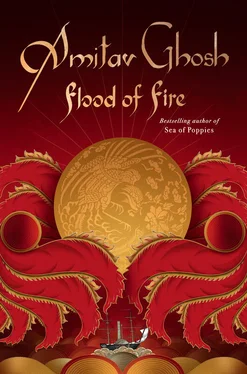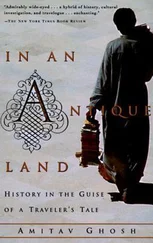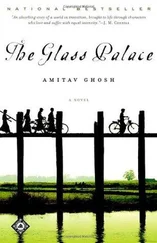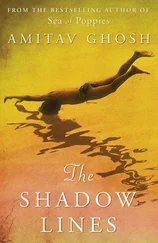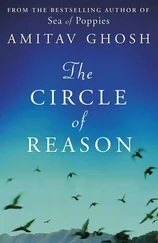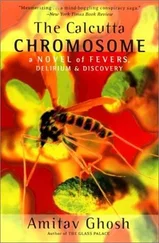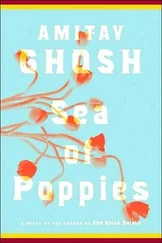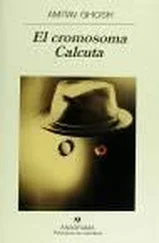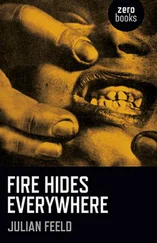But it appears that the British troops are preparing to do exactly that. According to the agent’s reports from Singapore, the soldiers have been conducting many drills, on land as well as water. One of their weapons has made a great impression on the townsmen because it bears a resemblance to the fireworks that light up the sky on Chinese New Year. The agent has learnt from an informer that the weapon is called a ‘Congreve rocket’ (these two words were written in English, on the margins of the letter, no doubt by the informer).
Zhong Lou-si asked if I knew anything about this weapon and I said no. He then asked if I could find out about it.
At first I was dumbfounded: where on earth was I going to find out about rockets?
But then I had an idea: I remembered hearing that there was a large library in the British Factory in Canton, with books on all manner of subjects.
The factory’s residents are all gone of course, but the building is still looked after by its Chinese servants, many of whom are employees of the merchants of the Co-Hong guild. It struck me that if prodded by Zhong Lou-si they might be able to arrange for Compton and myself to visit the library.
I put the idea to Zhong Lou-si and he was much taken with it: within a few hours we received word that the requisite arrangements had been made.
Shortly after sunset Compton and I went to the British Factory and were led through its deserted interior to the shuttered library, which is on the building’s highest floor.
The lib rary is much larger than I had thought, with comfortable leather armchairs, large desks, and rows and rows of glass-fronted bookcases. There were so many books that we were dismayed; we thought it would take us days to go through each of the shelves.
Fortunately there was a catalogue, lying on a desk. With its help I quickly located a treatise called The Field Officer’s Guide to Artillery : sure enough it contained a section on the Congreve rocket.
Turning to it, I discovered to my amazement that this rocket is actually a refinement of a weapon that was invented in India. Of course the Chinese have had rockets for centuries, but apparently they’ve only ever used them as fireworks, not for military purposes: rockets were first used as military weapons by Sultan Haider Ali of Mysore and his son Tipu, some forty years ago, during their wars with the East India Company. It was in south India, in the fortress of Bangalore, that rockets were adapted to carry explosives. Haider Ali used them to spread terror and confusion and caused the present Duke of Wellington some notable setbacks. Although the Mysore sultans were eventually defeated the British recognized the value of their innovation and sent a number of captured rockets to the Royal Arsenal in Woolwich, where one Mr William Congreve (a descendant of the playwright no doubt) then refined and improved the weapon. Since that time the British have used Congreve rockets in the Napoleonic wars and in the war of 1812. Now evidently they are planning to use them in China.
Compton and I lingered for hours in the library. We found several other ‘useful’ books — one on fortifications for example, and another on navigation — but to our disappointment there was nothing on steamships or boiler engines.
On our way out, I helped myself to a few books of my choice. It has been a long time since I last read a novel, romance or play: I scooped them off the shelves and stuffed them into my bag — Pamela, Love in Excess, Robinson Crusoe, The Vicar of Wakefield, Tristram Shandy , a translation of Voltaire’s Zadig , and a half-dozen more.
As we were about to leave my eyes fell on a book that stood out among the library’s sober tomes because of its brightly embossed spine: The Butterfly’s Ball and the Grasshopper’s Feast by William Roscoe.
It was the very edition that I’d bought for Raju in Calcutta when I started teaching him English, years ago; it cost a guinea as I recall, even though it was the cheaper, American edition. I could not resist it — I pulled it off the shelf and dropped it in the bag.
When I returned to my lodgings, the first book I took out of the bag was The Butterfly’s Ball and the Grasshopper’s Feast . I have read it to Raju so many times that I know it almost by heart. As I ran my eyes over the familiar illustrations, Raju’s voice filled my ears, lisping over the words:
Come take up your Hats, and away let us haste ‘To the Butterfly’s Ball …
I could feel my son’s weight on my lap and I could hear myself, correcting his pronunciation: ‘No, Raju — this is how you say it …’
The memories were so vivid that the book dropped from my hand and my eyes filled with tears.
To brood uselessly serves no purpose — that is why I do not dwell on the past; that is why I try not to think too much of Raju and Kamala. But The Butterfly’s Ball took me unawares and pierced my defences. It was as if an embankment had been swept away and I were floundering in a flood, trying not to drown in my own grief.
The eastern expedition’s fleet grew steadily larger as the days lengthened into weeks. The vessels from Madras trickled in slowly, bringing not only sepoys from the 37th Regiment but also two companies of sappers and miners and a substantial corps of engineers. But there were other ships still to come from Madras, notably the Golconda , which was carrying the regiment’s commanding officer, as well as the equipment, supplies and personnel for its headquarters establishment. The tardiness of these vessels kept the expedition at anchor in Singapore even as the men grew increasingly impatient to move on.
The month of May was almost over when Captain Mee summoned Kesri to his stateroom to tell him that the Golconda and another ship, Thetis , had been indefinitely delayed and would join the expedition later, off the China coast. There being no further reason for the fleet to tarry in Singapore, Commodore Bremer had ordered most of the fleet’s vessels to depart the next morning. They would proceed directly from Singapore to the mouth of the Pearl River.
‘How many days from here, sir?’
‘Ten to fifteen, I would say.’
The next morning, the departing ships were led out of the harbour by the Wellesley . The man-o’-war put on a splendid display, with crewmen standing erect on the cross-trees and stirrups, silhouetted against the billowing sails. The frigates followed in two rows, booming forward with their bows to the breeze, and then came the steamers, with the water frothing under their paddle-wheels. The troop-transports were the next to make sail, in groups of two and three.
On the Hind , the banjee-boys were up on the maindeck; they played a rousing tune as the ship’s sails filled with wind. Looking on from above, Zadig, Shireen and Freddie were charmed by the diminutive eleven- and twelve-year-olds, in their white uniforms. As for Raju, he did not know which way to turn — towards the band, or the Wellesley , or the steamers, or the azure waters ahead. The first thing he would tell his father, he decided, was that there was no grander sight on earth than that of a fleet setting sail.

The last leg of the Hind ’s eastwards voyage was markedly different from the first. From Calcutta to Singapore, the expedition’s vessels had sailed largely on their own, occasionally sighting each other or drawing alongside, but each travelling at their preferred pace. After leaving Singapore they sailed together, cruising in convoy, with the lofty skysails of the Wellesley leading the way.
Читать дальше
